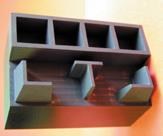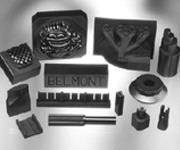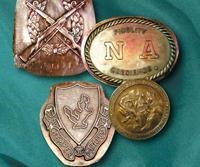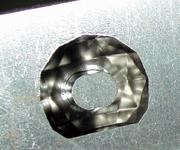Advantages and Disadvantages of Copper and Graphite Electrodes
Appears in Print as: 'Using Copper and Graphite Electrodes: Look at the Big Picture '
Both copper and graphite provide approximately the same end result, so it is important for a shop to consider the advantages and disadvantages of each material in order to discover what would work best in their shop floor environment.
When it comes time to decide whether to use graphite or copper electrodes in your shop, it's important to look at the big picture. According to Stu Haley, regional manager of Belmont Technologies, Inc., a provider of EDM supplies, tooling, accessories and machines, "To say which electrode works best is very difficult, it is totally applications driven. So much depends on what you have to work with on your shop floor in the way of support equipment. Both copper and graphite provide approximately the same end result. The difference is time to EDM the work and electrode manufacturing time and cost."
Haley explains that choosing an electrode material is often a result of where you were born and what type of EDM equipment you use. "For example, graphite was basically developed in the United States back in the early 1960s, so the American EDM equipment manufacturers in those days concentrated on the graphite circuitry when designing their equipment," he says. "Whereas, since the European and Asian EDM equipment manufacturers didn't have access to graphite, they developed copper circuitry.
Featured Content
"If you have newer equipment built after 1990, the electrode material of choice in North America is graphite," he adds. "This is used in 90% of the applications. In Europe and Asia, graphite is becoming more popular as an electrode material because of availability, machinability and speed of cutting."
Following are some of the advantages and disadvantages of each material so that you can decide which is best for your application.
Graphite
Advantages and Benefits
Sold by grades, graphite cuts approximately three times faster than copper, according to Haley. "What makes a good grade or a poor grade is particle size," he explains. "Particle size gives you strength, machinability and greatly influences the metal removal rate, wear and the surface finish. Graphite is made up of carbon particles that are put through a graphitizing process to produce graphite. The smaller the particle size is, the better the graphite. Particle sizes in different grades of graphite can be .0006" for general-purpose use to .00004" for the extremely fine detail and superior surface finishes. Graphite can be purchased in big blocks, and then cut up to be machined; or it can be ordered precut or ground into the size you require.
"Graphite machines very easily — you can mill it, grind it, turn it, drill it, tap it, even file it to whatever shape you want," Haley continues. "Another advantage of graphite is that it doesn't burr. You can put it on a duplicating machine or a graphite high-speed mill and cut out complex shapes and forms, and once it's cut you are finished — with no deburring." (See Figure 1)
Additionally, graphite's high melting temperature results in less wear than other electrode materials, so a mold could be cut with one or two electrodes on a CNC EDM machine with very little wear, Haley adds. "A CNC sinker may need a third or forth electrode to finish the mold," he notes. "It depends on the age of the EDM machines."
Limitations
If your shop has older fabricating equipment, machining graphite electrodes will result in dust particles on the shop floor and in the nearby machines. However, the new high-speed mills that are sold today are specially designed to machine graphite. "They are totally enclosed and have a vacuum system to remove all of the dust," Haley points out, "and there are some machines that can even cut square internal corners." (See Figure 2)
Another important point to keep in mind is that the finish on any electrode is the finish that will be put in the mold. "So, if you have a lot of cutter or grinding marks on the electrode, you will reproduce that in your mold," Haley says. "Normally, the finish on the graphite should be as good as you need in the mold." (See Figure 3)
Copper
Advantages and Benefits
Haley notes that copper can be cut on wire EDM machines, but there are only certain graphites that can be cut on a wire machine — the particle size should be five microns or less. Copper also is a little more forgiving in a poor flush situation than graphite. "In EDM, if the flush doesn't remove the eroded particles or chips out of the cutting area, there's something that can occur where you get a non-pulsating, direct flow of current from the electrode to the workpiece," Haley explains. "The result of this is a pit in the workpiece. Copper is more forgiving in those applications — all metallic electrodes are — they won't arc out as fast. But some of the newer EDM power supplies have adaptive logic or fuzzy logic, which eliminates the problem altogether. Copper — when used at specific settings with the correct flushing techniques using a CNC machine or a machine with an orbiting system — can produce a mirror-like surface finish. This is useful in small cavities where it is difficult to polish." (See Figure 4)
When you add tungsten to copper (copper tungsten), the result is an electrode material that has extremely good wear characteristics but is very difficult to machine, Haley notes. "When EDM'ing carbide, this is the best metallic electrode material to use. The best graphite material would be copper graphite, which is graphite impregnated with copper," he says.
According to Haley, there are alternative ways of machining copper — including coining (see Figure 5), forging, photo engraving/acid etching (see Figure 6) and stamping/forming. There are some shops that make a form and then copper plate it.
Limitations
"Copper is more difficult to machine," Haley says, "and when you mill it, it has the tendency to stick to the cutter. When you grind it, it can clog up the grinding wheel. It heats up quickly and has a tendency to grab the grinding wheel. You'll have burrs no matter how you machine it, so you have to deburr it. Size and weight also can be an issue. A 12" x 7" x 2 3/4" piece of copper weighs 75 pounds, whereas a piece of graphite the same size is 11 pounds.
"The bottom line is use what you think will work best in your shop with the equipment that you have available," Haley continues. "If some electrodes are beyond your machining ability, have someone make them for you. You have to base it on your own experience and the resources you have available. Ask for suggestions from the equipment manufacturer or from your electrode material supplier. Regardless of what electrode material or combination of materials you decide on, be sure that you know the speeds and feeds to machine the material safely. When in doubt, ask."
RELATED CONTENT
-
Technology and Sourcing Guide 2023: EDM
EDM refers to wire, sinker and small-hole electrical discharge machining. Components include drives, generators, programming, flushing, wires, electrodes, graphite, filters and fluids.
-
Technology and Sourcing Guide 2023: Mold Materials
Proper selection of the appropriate mold material is critical to manufacturing a high-quality mold. Tool steel, aluminum, copper and alloys are some of the materials used.
-
Discover Metalworking Technologies Targeted to Mold Shops
What EDM, automation and machining technologies are currently available to the mold manufacturing industry? MMT has compiled a list of some of the latest.


















